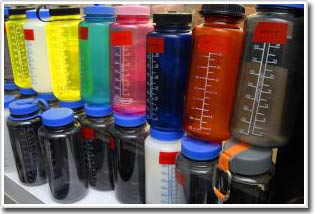Hot water releases harmful compounds in plastic bottles
According to scientists at the University of Cincinnati (UC), the active ingredient Bisphenol A (BPA) is released from polycarbonate bottles more or less independent of the bottle life, but the temperature of the liquid contained in the bottle.
Dr. Scott Belcher and colleagues discovered that when polycarbonate plastic bottles, both old and new, are exposed to hot water, BPA, a synthetic substance plays almost the same role as female hormones when absorbed. The body, discharged 55 times faster than before being exposed to hot water.
"The previous work has shown that if you regularly rub, wash or boil the polycarbonate bottles, they all release BPA," explains Belcher, assistant professor of pharmacology and cell physiology at UC. . It also means that BPA can exist in many types of polycarbonate plastics. But we want to know if normal use in everyday life can happen, and what is the deciding factor affecting this release process. '
'We start right away with tests based on how consumers use plastic water bottles and the biggest difference we have recorded is the amount of substance released relative to the liquid temperature. Bottles used for 9 years have a similar release of BPA as new bottles. '

Plastic bottles are used in the Bisphenol A. substance test study (Photo: UC)
BPA is one of the artificial chemicals that fall into the ' endocrine disruption ' group, meaning that they alter hormonal functions by mimicking the role of the body's natural hormones. Hormones are secreted through the endocrine glands and have many different functions in the body.
This chemical is widely used in products such as reusable water bottles, canned food liners, water pipes and fillings. They have the potential to affect reproductive and brain development in animal studies.
Blecher explains: 'There are a lot of scientific evidence that shows the harmful effects of very small amounts of BPA in the laboratory and in animal tests but there is very little medical evidence about its harmful effects on humans. . However, the scientific community is very skeptical of this compound's ability to adversely affect humans. '
Belcher 's group analyzed used polycarbonate water bottles from a local climbing gym and bought brand new bottles of water at a retail store. All of these bottles are passed on a 7-day test in normal situations such as traveling, climbing and other outdoor exploration activities.
UC researchers found that the levels of BPA released from old and new water bottles were the same in both quantity and speed - in warm and warm water conditions. However, this content is high when these bottles are exposed to hot water, even for a short time. Belcher said: ' When compared to the speed of the same bottle, this speed is 15 to 55 times faster. '
Before being exposed to hot water, the release speed of each bottle is about 0.2 to 0.8 nanograms / hour. Then this number is 8 to 32 nanograms / hour.
Belcher insisted that it was not clear how high BPA levels were dangerous for humans. He advises consumers how to care for substances that accumulate the environment to harm the body.
'BPA is one of the estrogen-like chemicals that people are exposed to, and scientists are still trying to clarify endocrine disruptors - including natural soy phyto-estrogens that humans still considered harmless - accumulating and affecting health. More and more scientific evidence proves that. '
- The habit of re-using plastic everyone does but brings unexpected harm
- The idea of water bottles made of jelly, decompose soon after use
- Why is little beer packed in plastic bottles?
- Do not drink bottled water for long periods in the hot sun
- 90% we do not know how to pour water out of plastic bottles properly
- Water bottles save the world: dissolved in sea water after 3 weeks, it doesn't matter what fish eat in
- 2 secrets about plastic bottles of water that many people would wish for 'I'd rather not know'
- Video: How to reuse plastic bottles with safe water
- Prohibit selling plastic water bottles to reduce garbage
- Anti-garbage with shells 'bottles' of edible water
- Don't inject plastic bottles to reuse many times, incalculable hazards
- Drinking water from this familiar item is as dirty as the toilet seat
 Green tea cleans teeth better than mouthwash?
Green tea cleans teeth better than mouthwash? Death kiss: This is why you should not let anyone kiss your baby's lips
Death kiss: This is why you should not let anyone kiss your baby's lips What is salmonellosis?
What is salmonellosis? Caution should be exercised when using aloe vera through eating and drinking
Caution should be exercised when using aloe vera through eating and drinking